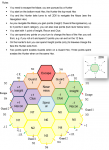Lanefan
Victoria Rules
Three questions, three out-of-sequence answers.I see your point re complexity and have follow-up questions:
1.) why would the current state need to modify the roll to determine the new state?
2.) why would I want to bother with 10-15 possible outcomes when the usual number is 2 and a sufficiently complex number is 4?
I guess one real question: what do I get out of doing that?
First, #2. The usual number of outcomes is by no means always 2 or 4 or whatever; and can sometimes be rather large. Sure it's possible to break everything down to binary options, but then you're going through multiple coin-flips to get through the resulting flowchart to arrive at an end result - and the current state still isn't influencing what comes next.
Second, #3. What you get is a rather elegant solution to the complex problem of having multiple possible current-states each of which have a hand in determining the next state.
Third, #1. Here I can best give an example - a weather table. Let's for these purposes say we already know it's warm enough that snow and ice aren't possible, for simplicity. Now, you could have a simple random weather table that looks like, on a d8
1. Sunny
2. Party cloudy
3. Cloudy
4. Intermittent rain or showers
5. Steady rain
6. Fog
7. Hail
8. Thunderstorm, tornado, or other extreme
This is flawed all over the place even to use as a random starting point, as the frequency of occurrence of hail or thunder is far less than of sunshine or partial cloud; a weighted d% table would be better. For determining the weather at any given random time without reference to anything else, you could roll on the weighted d% table and just stop there; and you'd do this for a starting point in any case.
But. The weather right now is extremely likely to have an influence on what the weather will be an hour from now, or even a day from now - and here's where the variable odds have to come in.
Simply put, if it's sunny right now the chances are high that it'll still be sunny an hour from now; but if it's raining right now the chances of it being sunny in an hour are much lower (though not zero). There are also - were we to fine-tune this even further and add more options - some weather phenomena that almost never occur within an hour of each other e.g. fog and hail. How can we design a table that'll at least vaguely reflect the weighting of the odds provided by the current state?
And this particular example wouldn't even work properly on the hex flower unless some of the hexes had different odds of movement than others. Why? Because some weather phenomena simply don't last as long as others. For example it pretty much never hails for more than an hour at a time, and thunderstorms tend to roll through in a few hours at most; so here the odds of the current state remaining the same need to be pretty low. But sunshine or partial cloud or rain are more stable, thus the odds of the current state remaining true in an hour need to be quite high*.
* - if one really wanted to get messy, the odds of change should very slowly become greater based on how long the current state has remained the same - a "stability factor", as it were.
And yes, you could beat this all down to a simple "things get worse, things stay the same, things get better" query, but I don't just want the roll to tell me that; I want it to also more specifically tell me how and-or in what way things get better-worse-the same.
It's sunny, and I roll "things get better"; but you can't get better than sunny. It's sunny, and I roll "things get worse" - does that mean it's now cloudy, or raining, or foggy, or what? How much worse? Is a tornado coming?
Weather is just one example of many where the current state can often affect the future state and thus for randomization purposes needs to be taken into account.
Lan-"and I didn't even bring windspeed-direction into the above mess - be thankful!

